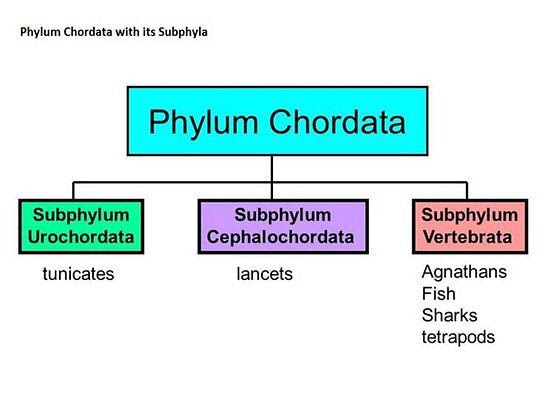
What is the largest subphylum of chordates?
Answer
389.4k+ views
Hint: Chordates are living beings that are classified in the kingdom Animalia. It is a group of animals or phylum, which includes three subphyla, namely, Vertebrata, Urochordata (tunicates), and Cephalochordata (lancelets). Chordates possess a notochord, pharyngeal gill arches, thyroid gland, post-anal tail, and tubular nerve cord.Inthe animal kingdom, the Chordata is the third-largest phylum.
Complete answer:

Fig: Classification of Phylum Chordata into its Subphyla
Vertebrates contribute the vast majority of chordates. There are eight classes of vertebrates. Four are aquatic and four are terrestrial or semi-terrestrial (amphibians). The four aquatic subphyla can be grouped as superclass fishes or Pisces. They are grouped as superclass Tetrapoda or four-footed animals.
Vertebrata is the largest and most diverse subphylum of chordates, with its evolution supported by efficient respiration, advanced nervous system, paired limbs, and the living endoskeleton.
The largest subphyla of chordates are vertebrates, which are inclusive of
Vertebrates include all animals, which possess a central nervous system, gills, and backbones, during at least one phase of development. They include reptiles, mammals, birds, amphibians, jawless fishes, sharks, rays, and bony fishes.
All the vertebrates are built along with a vertebral column running throughout the length of the animal with a spinal cord or tube of nerve tissue, gastrointestinal tract below it, and a basic chordate body plan. The cord is generally made of bones.
Note:
The blue whale is the world’s biggest chordate. It is even larger than the dinosaurs. The population of the blue whale is less than
Complete answer:

Fig: Classification of Phylum Chordata into its Subphyla
Vertebrates contribute the vast majority of chordates. There are eight classes of vertebrates. Four are aquatic and four are terrestrial or semi-terrestrial (amphibians). The four aquatic subphyla can be grouped as superclass fishes or Pisces. They are grouped as superclass Tetrapoda or four-footed animals.
Vertebrata is the largest and most diverse subphylum of chordates, with its evolution supported by efficient respiration, advanced nervous system, paired limbs, and the living endoskeleton.
The largest subphyla of chordates are vertebrates, which are inclusive of
Vertebrates include all animals, which possess a central nervous system, gills, and backbones, during at least one phase of development. They include reptiles, mammals, birds, amphibians, jawless fishes, sharks, rays, and bony fishes.
All the vertebrates are built along with a vertebral column running throughout the length of the animal with a spinal cord or tube of nerve tissue, gastrointestinal tract below it, and a basic chordate body plan. The cord is generally made of bones.
Note:
The blue whale is the world’s biggest chordate. It is even larger than the dinosaurs. The population of the blue whale is less than
Recently Updated Pages
Master Class 11 Economics: Engaging Questions & Answers for Success

Master Class 11 Business Studies: Engaging Questions & Answers for Success

Master Class 11 Accountancy: Engaging Questions & Answers for Success

Master Class 11 English: Engaging Questions & Answers for Success

Master Class 11 Computer Science: Engaging Questions & Answers for Success

Master Class 11 Maths: Engaging Questions & Answers for Success

Trending doubts
State and prove Bernoullis theorem class 11 physics CBSE

1 ton equals to A 100 kg B 1000 kg C 10 kg D 10000 class 11 physics CBSE

State the laws of reflection of light

One Metric ton is equal to kg A 10000 B 1000 C 100 class 11 physics CBSE

Difference Between Prokaryotic Cells and Eukaryotic Cells

1 Quintal is equal to a 110 kg b 10 kg c 100kg d 1000 class 11 physics CBSE




